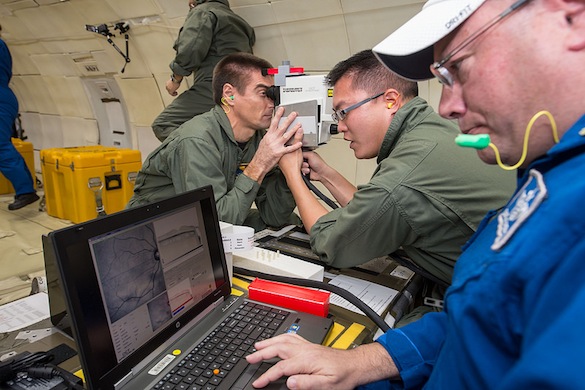Optical Coherence Tomography (OCT) in Microgravity
PI: Doug Ebert, Wyle Laboratories Inc.
PI: Doug Ebert, Wyle Laboratories Inc.

- TA06 Human Health, Life Support and Habitation Systems
No information available.
This experiment evaluated alternate OCT hardware configurations in microgravity, including ergonomic and operational considerations for each configuration. Scan settings were optimized for rapid exams that were possible during the timeframe of single parabolas, and also for examining physiologically relevant regions that were expected to respond to acutely altered gravity. One of the most significant results is that handheld OCT was possible in microgravity. This result provides options for OCT placement on ISS that were not previously considered, and could potentially reduce setup time for ISS crews. This result also allows OCT experimentation in combination with other equipment (e.g. the Russian “chibis” lower body negative pressure suit) that would not have previously been possible. OCT and intraocular pressure data collected during this experiment will help define physiological changes in altered gravity and may serve as important pilot data for ISS inflight studies.
Over the course of the development of this evaluation, the OCT scanner has been flown to ISS and is now in operational use in its standard configuration. Deployment of flight hardware does not typically occur on this accelerated schedule, but due to the need for more information about the VIIP problem, a high priority has been placed on this hardware. The current ISS configuration has several shortcomings that have been partially addresses through this parabolic campaign. Primarily, this evaluation has shown that handheld scanning is a possibility in microgravity, and has provided preliminary operations concepts and validation of prototype modifications that enable this scanning mode. This evaluation has also provided physiological data about the eye during gravitational transitions. These advances have opened possibilities for ISS crew time savings, increased flexibility for medical equipment deployment, expanded research applications of medical hardware, and also provided new data that will contribute to solving the VIIP problem.
Technology Details
-
Selection DateAFO6 (Jun 2013)
-
Program StatusCompleted
- 1 Parabolic
Development Team
-
PIDoug Ebert
-
Organization
-
SponsorWyle Laboratories

